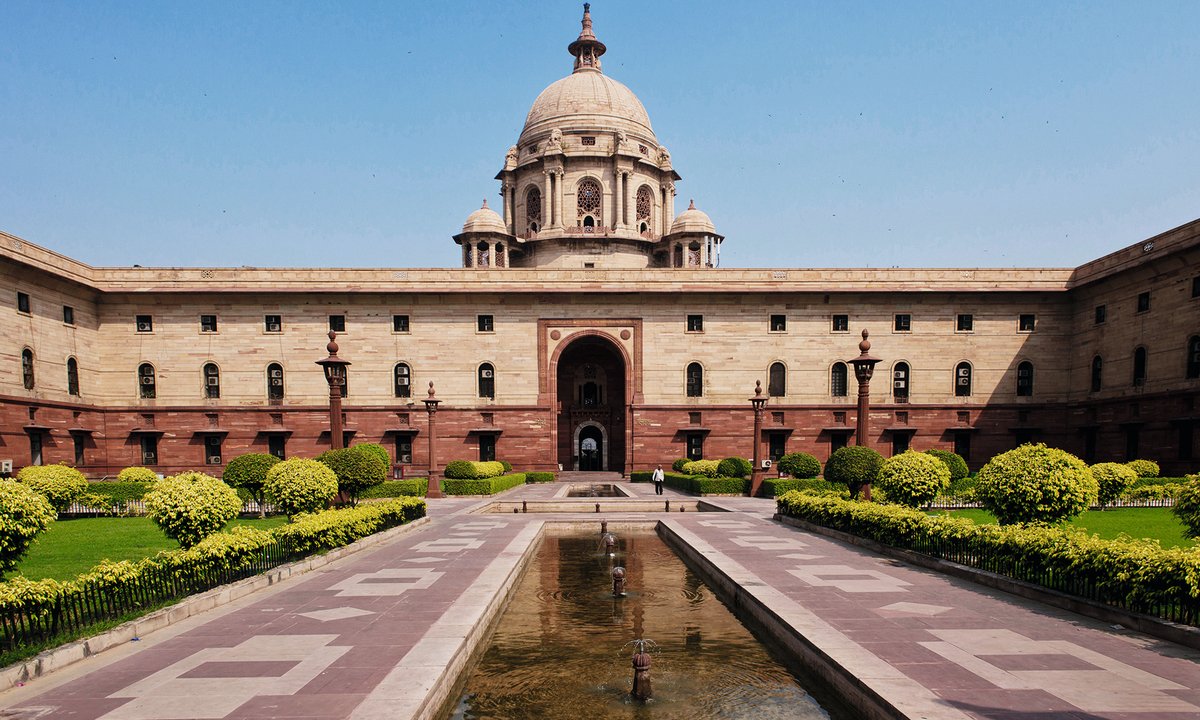The North Block of the Secretariat building in New Delhi, built during the British Raj. It is the proposed venue for the new National Museum National Photo: © Fabio Lotti/Alamy
In December, India’s Ministry of Culture signed a partnership agreement with the French government to develop the Yuga Yugeen Bharat National Museum (YYBNM) in New Delhi, which it claims will be the world’s biggest museum upon completion. The YYBNM will replace the existing National Museum of India as part of the Central Vista Redevelopment Project that is transforming the capital’s administrative area, under Prime Minister Narendra Modi.
But while India’s grandest state museum project of the 21st century forges ahead, crucial details remain unknown to both the public, as well as some of India’s leading museum figures. These include the proposed budget, plans for the current National Museum building and provisions to safeguard its collection. Spokespeople for both the National Museum and the ministry of culture did not respond to questions from The Art Newspaper regarding the YYBNM project. Meanwhile, officials at France Muséums Développement (FMD), the private French organisation tasked by the French government to advise the YYBNM, declined to speak to The Art Newspaper.
The YYBNM will be housed in the Central Secretariat buildings on Raisina Hill, comprising the North Block and South Block, which will together provide the new museum with a floorspace of “approximately 155,000 sq. metres”, according to a government release from December 2024. Designed by Herbert Baker in 1912 and completed in 1927, these buildings are emblematic of British colonial rule. The Modi government argues that, apart from logistical reasons, the Central Vista redevelopment is a move to rid India of its colonial legacy. The FMD, whose previous projects have included the Louvre Abu Dhabi, will advise on the “restoration and conservation of the buildings” and “adaptive reuse of the building and facilities”, the release states. Commenting on the government’s move to partner with FMD to develop the new national museum, Jawhar Sircar, the former culture secretary and member of parliament, tells The Art Newspaper, “As if the French are less colonial.”
As yet, there is little information available to the public on the new museum plans, a fact that extends even to those who are meant to be consulting on the project. Tasneem Zakaria Mehta, a curator and the honorary director of Mumbai’s Dr Bhau Daji Lad Museum, says that she was invited to be an adviser for the YYBNM by the ministry of culture, but has not been called to meet on the project since 2022. She identifies that “the space of the North and South Blocks will be tricky to repurpose into a museum, these are colonial structures with a warren of rooms and offices inside".
The BJP government has initiated several redevelopment projects in Delhi. This includes demolishing the Hall of Nations and adding a new museum to Teen Murti dedicated to all prime ministers. Both the moves have been criticised as an attempt by the government to rewrite history through a Hindu nationalist lens. The Central Vista project is the largest such project and is estimated to cost the public exchequer about 200bn rupees ($2.3bn). Work on the project began in December 2020. At the time of publication, an estimated budget for the YYBNM had not been released. The latest India Union Budget, released on 1 February, makes no mention of the project, but states that the government has allocated 450m more rupees ($5.1m) to the development of museums, which is related to the "expenditure of the activities relating to Museum Grant Scheme, Scheme for Promotion of Culture of Science Redevelopment of Kedarnath Project and National Experiential Site Museum at Vadnagar".
Of chief concern and as yet unclear is the fate of the existing National Museum, which opened in 1949 and shifted to its present site in 1955. In May 2021, it was included in a list of several iconic Central Vista buildings that would be demolished, as reported in the India media. Seven months later, a representative of the ministry of culture stated in Indian Parliament that no decision had been taken about demolishing the structure, in response to a question by Sircar, who was then an MP for the Trinamool Congress Party. Sircar asked the same question in parliament on 21 July 2022, 7 December 2023, and 1 August 2024, and received the same response each time. He characterises the replies as “evasive”.
By 2022, it had been clarified that the museum would be shifted to the North and South Block. On 21 July 2022, Sircar also asked the ministry if it was consulting subject specialists about shifting the national collection: the ministry said, “Consultation is a continuous process.” Sircar says that a sizable portion of the National Museum, around 20,000 artefacts, are “irreplaceable national treasures”.
How the government intends to fill the vast space of the YYBNM is also an issue. On 25 July 2024, Sircar asked the ministry whether all the antiquities of the old museum would be displayed at the North and South Block. “The proposed museum is likely to have artefacts from not only the National Museum but also other museums in India,” the minister responded. This response is attested to by Mehta, who says that to her knowledge “the central government museums will see many of their artefacts that are sitting in storage transferred to the YYBNM”. The Art Newspaper understands these museums to include the Indian Museum in Kolkata and the Government Museum in Chennai.
The existing National Museum, inaugurated in 1955 by India’s first prime minister, Nehru. It holds 200,000 objects which will need rehousing National Photo: © Jeremy Graham/Alamy
On 1 August 2024, the ministry said that restoration of the North and South Block would begin after the existing offices in them are emptied. The North and South are presently high-security buildings that house some of India’s most important offices, including those of the prime minister, Ministry of Defence and Ministry of External Affairs. But the ministry has not released a timeline as to when the move will happen. Another key concern is how the government plans to shift artefacts from the National Museum to the new museum.
Further details were revealed in a video made by Tagbin, a Gurgaon-based immersive tech company which has worked on several projects with the BJP. The video was displayed at the International Museum Expo in 2023 in New Delhi, where plans for the YYBM were first announced. Officials reportedly said during the expo that the YYBNM would span 5,000 years of Indian history and tell the story of India, from its ancient cultures through to various eras of colonial rule and its fight for independence.
The National Museum holds more than 200,000 objects, artefacts and antiquities, according to its website. Experts have noted that there was a need for improvement at the museum. A former bureaucrat in the culture ministry, speaking anonymously, says that there are “huge gaps if you look at the collections elsewhere—there are several other collections which can talk about a better set of objects for a certain historical period. But in terms of its range, I think the National Museum collection is unparalleled in the country.” The bureaucrat thinks that the collection also represents the diversity of the country “to a great degree”, but not comprehensively. Sircar also notes that there is a “dire need for additional space”, but not for “coming up with questionable ideological museums”.
Since the BJP came to power in India in 2014, numerous commentators have pointed out the party’s tendencies to hollow out public institutions to serve its agendas. A few months before the BJP came to power, Venu Vasudevan, a civil servant, became the director general of the National Museum for a three-year term. Several news reports credit him for transforming the museum. “During Venu’s tenure, four dead galleries came back to life, a new garden café was started, the Outreach department was strengthened, the museum was opened up to scholars and students, and recalibrated in consonance with international standards,” reported the Indian Express. “Many landmark exhibitions were also held, such as Nauras [the Many Arts of the Deccan] and The Body in Indian Art.” These efforts reportedly increased visitors by 30% and merchandise sales by 112%. However, within a year of the BJP rule, Vasudevan was removed from the post. Leading cultural figures in India protested against this with an online petition. “I still have no idea why I was moved out,” Vasudevan, who retired from government service last year, tells The Art Newspaper.
The former culture ministry bureaucrat who spoke to The Art Newspaper anonymously thinks that the government “wanted someone more aligned to their political beliefs or philosophy”. The bureaucrat mentions that under Vasudevan’s tenure, there were liberal discussions and space was given to people who were critical of the BJP.
Since 2016, the National Museum has been led by the director general Buddha Rashmi Mani, a former Archaeological Survey of India (ASI) official, During his time at the ASI, Mani led the 2003 survey of the site of the Babri mosque—razed to the ground by Hindu extremists in 1992—and reported that a 10th-century temple had been found under the 16th-century mosque. The report vindicated far-right Hindu nationalist groups, with whom the BJP is ideologically aligned, and which had claimed for decades that there was a temple under the mosque and that the site was the birthplace of Ram. Several experts have argued that there is a dearth of evidence behind these claims. An ASI official told the Indian publication The Caravan “that leading such a survey was a clear path to finding favour with the government”.
Whether Mani will lead the YYBNM is as yet unconfirmed. “It is unclear who will be the director of the new museum, but it should be someone of international standing,” Mehta says. The Print reported in 2023 that employees at the existing National Museum feared for their jobs due to a lack of clarity over future plans.
Mehta identifies the biggest issue currently facing the YYBNM is “the huge dearth of curatorial expertise in India, especially for pre-Modern art. There is simply not enough money going into soft infrastructure for art. If you want to build the biggest museum, you must also invest behind the scenes to sustain it. If this museum wishes to be truly global, its leadership staff need to play a curatorial and administrative role on par with their global peers, to be able to communicate the museum’s programme on an intellectual level around the world”. Ultimately, Mehta feels the “YYBNM could be a great project. It is time we focus on our museums and this project is a strong message from the state that it is finally taking our cultural institutions seriously. Provided it does not focus only on navel gazing and includes Modern and contemporary art”.
Ram Rahman, a prominent photographer and curator, is also concerned about the museum’s ability to meet international standards. When pointing out that the buildings will be refurbished, he says that logically it would have been possible to build a new modern museum on the land next to the existing structure: “Why go to an older building which could be used for other purposes?”
Ideological concerns also abound. The government has claimed that the museum will represent India’s diversity, but it faces numerous allegations of promoting divisiveness among religious groups. “The whole idea is to change the narrative into the Hindutva narrative of history,” Rahman says. Sircar holds similar reservations: “If anybody has crushed diversity in the last 1,000 years, it is them. Let’s not talk about diversity.”
A number of the Indian capital's major cultural institutions, including the National Museum, will be rehoused
Directors modernising formerly moribund museums are being undermined by Hindu extremists
The architect's vision for the new Kiran Nadar Museum of Art in Delhi, opening 2026, honours India's multiple cultures and religions at a time of heightened nationalist politics

